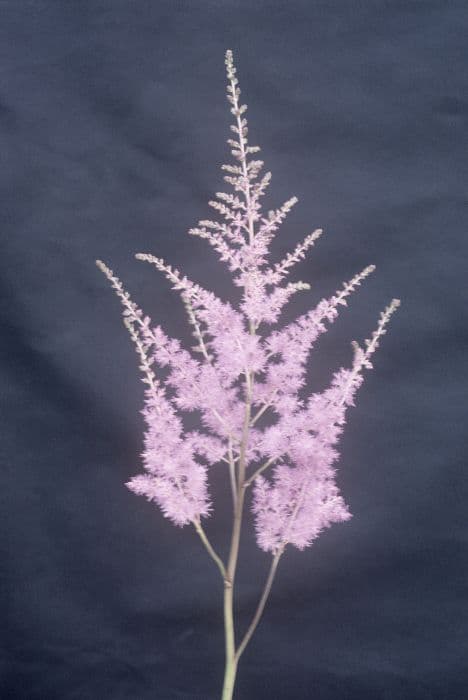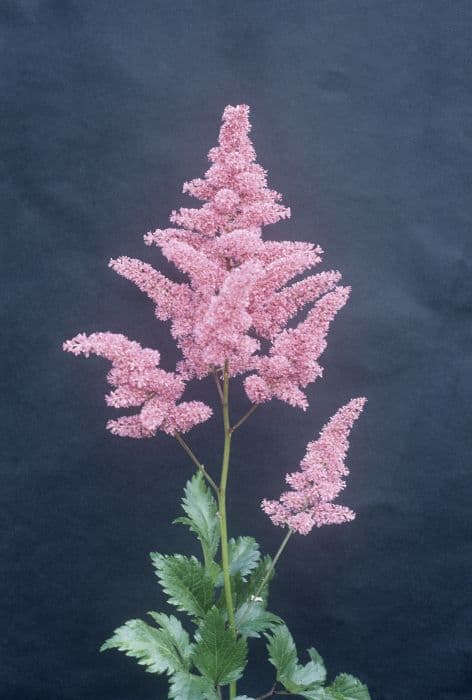Coral Bells Heuchera 'Amber Waves' (PBR)

ABOUT
The 'Amber Waves' variety of coral bells is a particularly striking ornamental plant known for its vibrant foliage and attractive flowering stems. This plant boasts a cascade of ruffled leaves with a unique amber to golden-yellow hue that adds a splash of warm color to any garden setting. Its leaves are noted for their shiny, almost metallic finish, and the delicate veining that often shows shades of lighter yellow or green, providing a pleasing contrast. In addition to its distinct foliage, the coral bells 'Amber Waves' also produces slender stems that rise above the leaves bearing airy panicles of small bell-shaped flowers. These blooms are typically creamy white to light pink in color and add a whimsical, airy touch as they sway gently in the breeze. The overall appearance of this plant is one of soft, mounded foliage paired with delicate floral accents, making it a favorite among gardeners looking to introduce some radiant color and texture to their landscapes.
About this plant
 Names
NamesFamily
Saxifragaceae
Synonyms
Coral Bells, Alumroot
Common names
Heuchera 'Amber Waves'
 Toxicity
ToxicityTo humans
Coral Bells, which includes the variety Heuchera 'Amber Waves', is generally considered non-toxic to humans. Therefore, it is not known to cause serious illness or symptoms of poisoning if ingested.
To pets
Coral Bells, which includes the variety Heuchera 'Amber Waves', is generally considered non-toxic to pets such as cats and dogs. Ingestion of this plant should not typically result in any serious symptoms of toxicity or poisoning for pets.
 Characteristics
CharacteristicsLife cycle
Perennials
Foliage type
Evergreen
Color of leaves
Amber
Flower color
White
Height
1 feet 8 inches (50 cm)
Spread
1 feet 2 feet (30-60 cm)
Plant type
Herb
Hardiness zones
4-9
Native area
North America
Benefits
 General Benefits
General Benefits- Attractive Foliage: 'Amber Waves' Coral Bells are known for their vibrant, ruffled amber to golden leaves that provide year-round interest in the garden.
- Low Maintenance: Once established, this variety requires minimal care beyond occasional watering and removal of spent foliage.
- Drought Tolerance: This plant has a good tolerance for dry conditions once established, making it suitable for water-wise landscapes.
- Cold Hardy: It can survive and thrive in cold temperatures, making it a good choice for gardeners in regions with harsh winters.
- Attracts Pollinators: The delicate bell-shaped flowers that bloom in late spring to early summer attract butterflies and hummingbirds.
- Versatile in Landscaping: This Heuchera works well as a groundcover, in rock gardens, or as border plants due to its mounding habit and interesting foliage.
- Shade Tolerant: 'Amber Waves' Coral Bells can thrive in part shade, offering a colorful foliage option for darker areas of the garden.
- Resistant to Pests and Diseases: They are generally resistant to deer and rabbits, as well as many common plant diseases.
- Long Blooming Period: The flowers can provide visual interest throughout the spring and early summer months.
 Medical Properties
Medical PropertiesThis plant is not used for medical purposes.
 Air-purifying Qualities
Air-purifying QualitiesThis plant is not specifically known for air purifying qualities.
 Other Uses
Other Uses- Artistic Inspiration: The unique coloration of Heuchera 'Amber Waves' can serve as a muse for artists and designers looking for natural shades and textures to incorporate into their work.
- Educational Tool: This Heuchera variety can be used in schools or educational gardens to teach about plant genetics, hybridization, and the development of patented plant varieties.
- Jewelry Making: Pressed leaves of the 'Amber Waves' can be encased in resin to create unique botanical jewelry pieces such as pendants or earrings.
- Culinary Garnish: Although it’s not a usual herb, the edible leaves can add a colorful garnish to upscale dishes in creative cuisine, assuming nontoxic treatments are used on the plant.
- Photography Subject: The striking foliage provides an excellent subject for macro photography, helping photographers to practice focus and play with subtle color contrasts.
- Leaf Casts: The textured leaves of Heuchera 'Amber Waves' make it ideal for creating decorative leaf casts for garden art or wall hangings.
- Garden Theme Creation: This plant can serve as a central theme in a 'waves of color' garden design, emphasizing flow and movement through color variation.
- Bioindicator: In a carefully monitored environment, Heuchera 'Amber Waves' could serve as a bioindicator plant, showing signs of distress in response to certain environmental pollutants or soil conditions.
- Companion Planting: It can be used as a companion plant to highlight and accentuate the colors of nearby flowers and plants in landscape design.
- Seasonal Decor: The leaves can be harvested in fall to create natural, autumn-themed arrangements or wreaths for seasonal home decor.
Interesting Facts
 Feng Shui
Feng ShuiThe Heuchera, commonly known as Coral Bells, is not used in Feng Shui practice.
 Zodiac Sign Compitability
Zodiac Sign CompitabilityThe Coral Bells is not used in astrology practice.
 Plant Symbolism
Plant Symbolism- Resilience: Heuchera, commonly known as Coral Bells, is known for its ability to thrive in a variety of climates and conditions, symbolizing the capacity to endure and adapt to life's challenges.
- Longevity: With the right care, Coral Bells can live and continue to flourish for many years, representing lasting beauty and perseverance.
- Attractiveness: The ornamental leaves of the 'Amber Waves' cultivar, with their unique amber coloration, symbolize aesthetic appeal and the value of standing out in a crowd.
- Variety: The diverse range of colors and forms found within the Heuchera species reflects the theme of diversity and the importance of embracing different perspectives and characteristics.
 Water
WaterThe Coral Bells 'Amber Waves' should be watered deeply to ensure moisture reaches the roots, with an average of 1 inch of water per week. Allow the soil to dry out slightly between waterings to prevent root rot. In hot, dry periods, you may need to water twice a week, but always check soil moisture before doing so. Overhead watering is discouraged as it can promote fungal diseases; instead, water at the base of the plant. Consistently provide the plants with about 0.5 gallons per square foot every week, adjusting as necessary for climate and soil conditions.
 Light
LightCoral Bells 'Amber Waves' thrives in partial shade to full shade conditions. The ideal location is where it can receive morning sunlight and is protected from the harsh afternoon sun. Filtered sunlight under a canopy of trees or an eastern exposure is best, ensuring the vibrant foliage maintains its color without getting scorched by too much direct sunlight.
 Temperature
TemperatureCoral Bells 'Amber Waves' can survive in temperature extremes ranging from as low as 0°F to highs up to 80°F, but they flourish best when the temperature is maintained between 60°F to 70°F. They are hardy plants that can tolerate winter cold but may need protection from extreme heat, especially in regions with hot summers.
 Pruning
PruningPrune Coral Bells 'Amber Waves' to remove dead or damaged leaves and to shape the plant in early spring or after flowering. Pruning is also necessary to encourage new growth and maintain a tidy appearance. Cut back the foliage to the ground if it becomes ragged or tattered after winter. Deadheading the spent flowers will promote additional blooming.
 Cleaning
CleaningAs needed
 Soil
SoilCoral Bells thrive in well-draining soil rich in organic matter, with a preferred pH range of 6.0 to 7.0. A mix of two parts garden soil, one part peat moss, and one part perlite or coarse sand creates an ideal soil environment. Amend soil with compost annually to maintain fertility and structure.
 Repotting
RepottingCoral Bells should be repotted every 3-4 years to refresh the soil and prevent overcrowding. Early spring or fall is the best time to repot, giving the plant time to establish before extreme weather.
 Humidity & Misting
Humidity & MistingCoral Bells prefer moderate humidity but are adaptable to a variety of conditions. Aim to maintain a humidity level around 50%. They are tolerant of drier air but may benefit from occasional misting in very dry environments.
 Suitable locations
Suitable locationsIndoor
Place in bright, indirect light with well-draining soil.
Outdoor
Plant in partial shade with moist, rich soil.
Hardiness zone
4-9 USDA
 Life cycle
Life cycleHeuchera 'Amber Waves', commonly known as Coral Bells, begins life as a seed, which germinates in moist, well-draining soil with some degree of shade. Upon germination, the seedling emerges, gradually developing into a rosette of amber-colored leaves with a ruffled texture. As the plant matures, it forms a clump with its evergreen foliage, providing year-round interest. In late spring to early summer, Coral Bells produce delicate, bell-shaped flowers on thin, erect stems that rise above the foliage, attracting pollinators such as bees and hummingbirds. After the blooming period, seeds develop and are dispersed, potentially giving rise to new plants; meanwhile, the parent plant may continue to grow and spread through its rhizomatous root system. Over several years, Coral Bells may become dense and may require division to rejuvenate and maintain their vigor.
 Propogation
PropogationPropogation time
Spring-Early Summer
The most popular method of propagation for Heuchera 'Amber Waves' is by division. This perennial plant can be propagated in spring or fall by carefully digging up the entire plant and gently separating it into smaller clumps, ensuring that each new piece has at least one growing point or shoot with attached roots. The divisions can then be replanted in well-draining soil, spaced about 12 to 18 inches (approximately 30 to 45 cm) apart, to allow enough room for growth. It is important to keep the transplants well-watered until they are established, which can take a few weeks. Dividing Heuchera not only helps in the propagation of new plants but also rejuvenates older clumps that may have become woody in the center.









